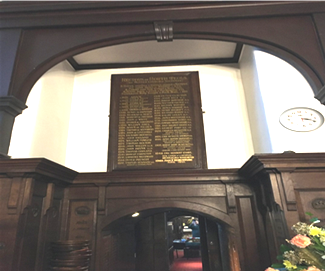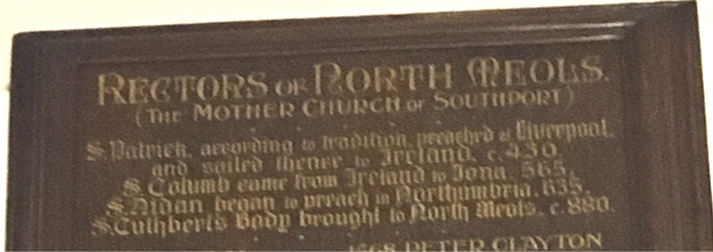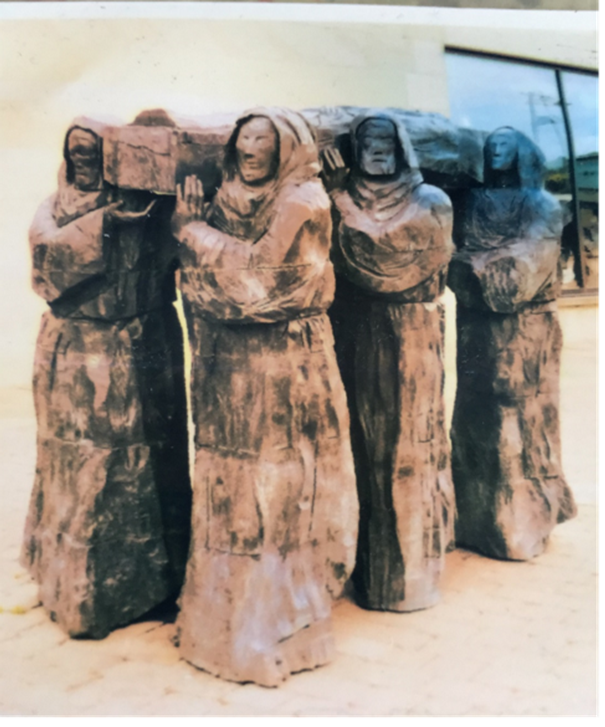ST CUTHBERT
 A few years ago, as I walked into St. Cuthbert’s Church, I looked up to my left, probably for the first time in my thirty-odd years as a parishioner. My eye was taken by this wooden panel, high up on the wall:
A few years ago, as I walked into St. Cuthbert’s Church, I looked up to my left, probably for the first time in my thirty-odd years as a parishioner. My eye was taken by this wooden panel, high up on the wall:
I could see perfectly well that it was a list of the Rectors of St Cuthbert’s, going back to the year 1178 – nearly eight hundred and fifty years ago! What I had to climb up in order to see properly was the sentence: “St Cuthbert’s body brought here c. 880”

When I asked why St Cuthbert’s body had been “brought to North Meols”, the original site of St Cuthbert’s Church, I could not get an answer. Then I discovered that ten miles away in the village of Halsall, there was another St Cuthbert’s Church of similar age – and with a similar claim to be a resting place of the body. Since then, I have been in contact of various kinds with 41 such churches across the northern counties of England and the southern counties of Scotland. How did St Cuthbert’s body get here? What route did it take? Why here? Why Cuthbert?
It might be useful to ask why it should have been Cuthbert who was being given so much attention. Why was he so special?
The gist of his background is that he was born in 635 (in the same year that Aidan founded the monastery on Lindisfarne). He came from a well-to-do family and was brought up a Christian, but was also taught the arts of war. On 31st August 651, i.e. when he was sixteen, he was out guarding sheep against northern raiders, when he saw a vision of Aidan’s soul being taken to Heaven. That decided him on a monastic career. He spent the next thirteen years as a monk at Melrose.
In 665 he moved to Lindisfarne as a missionary, spiritual guide and healer. In 685 he became a bishop, but lasted only two more years. Cuthbert died at the age of fifty-two in 687 and was buried on Lindisfarne. Eleven years later, his body was exhumed and found to be incorrupt. This, together with reports of miraculous deeds, served to confirm Cuthbert as both saint and cult figure with radiant powers of healing and influence.
Of his miracles there are many stories, told in documents still lodged in the Library of Durham Cathedral.
For example:
* An angel cured Cuthbert’s swollen knee.
* Cuthbert rescued boats off Tynemouth by the power of his prayer.
* Cuthbert’s horse pulled down meat and bread from the thatched roof of a hut during a journey to Melrose.
* Whilst Guest-Master at Ripon he received a visit from an angel and subsequently found three Heaven-sent loaves.
* At Coldingham he prayed all night standing in the sea and at dawn his feet were dried by otters.
* He was supplied miraculously with a dolphin, sliced in three and ready for cooking.
* An eagle brought him fish.
* His prayer extinguished a fire set up by the devil.
* Crows left his crops alone after he reproached them.
* One crow, reproached for damaging his thatch, made amends by bringing him lard.
* He cured Abbess Aelfleda and a nun with his girdle.
* He turned water into wine.
* The water of the stormy sea into which the Gospel fell turned to blood.
* Cuthbert’s body remained “incorrupt” for many years after his death.
* A paralytic was cured by putting on Cuthbert’s shoes.
* A youth was cured of a tumour in the eye by touching it with a hair of the saint belonging to the Priest Thuidred.
* The dead Cuthbert “killed” Viking leader Ragnall for stealing his land.
He was obviously a “celebrity” who needed to be persuaded to accept the Bishopric of Lindisfarne (or of Hexham, which he then swapped for Lindisfarne). It took the Archbishop of Canterbury and the King to convince him, and then only after repeated requests!
Cuthbert’s body lay undisturbed and his stature as a cult figure grew and grew over the next hundred and six years. Then on 8th January 793, according to the Anglo-Saxon Chronicles, “the harrying of the heathen miserably destroyed God’s church in Lindisfarne by rapine and slaughter”. Most of the monks were either slain or taken into slavery. The few escapees regrouped and trained replacements. They found that the grave of Cuthbert had remained unharmed.
Then, in the Winter of 875, it was reported to the monks that Halfdan was anchored in the mouth of the River Team, preparing to attack Northumbria in the Spring of 876. So Eardwuf, the Bishop of Lindisfarne and Abbot Eadred of Carlisle, dug up the body once again, together with ceremonial vestments, the beautiful illuminated manuscript known as the Lindisfarne Gospels, and relics including St Oswald’s head and parts of the skeleton of St Aidan, plus some bones of earlier bishops, put them into a coffin and made their getaway.

For the next eight years they made their way west, to the mouth of the River Derwent, near to the modern Workington; then south, to Lytham, North Meols and Halsall; then east to Ripon; then north arriving at Chester le Street. For the next century they felt safe, until the Vikings reappeared, bent on capturing the prize.
Once more seeking security, the monks carried Cuthbert’s coffin south to near York, then north again to the place where his body is said to rest to this day – behind the altar of Durham cathedral.
Keith Hamnett
Church Member